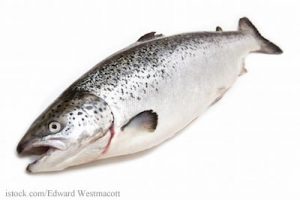The Center for Food Safety (CFS) has published a review on the safety of genetically engineered salmon. Scientists are currently experimenting on more than 35 species of fish. They are using genes from other fish, coral, mice, bacteria, and people to produce new breeds of transgenic fish that grow faster, are resistant to disease, and tolerate wide temperature ranges.
 The FDA is currently considering GE salmon produced by AquaBounty for approval. The Atlantic salmon has growth hormone from the Chinook salmon and anti-freeze DNA from an Arctic eelpout spliced into its DNA. The fish may grow up to twice as fast as conventionally raised Atlantic salmon.
The FDA is currently considering GE salmon produced by AquaBounty for approval. The Atlantic salmon has growth hormone from the Chinook salmon and anti-freeze DNA from an Arctic eelpout spliced into its DNA. The fish may grow up to twice as fast as conventionally raised Atlantic salmon.
CFS says that the problems with the altered fish start with how government assesses risks. They use old laws and a low level of analysis. When these new animals are developed, companies file a New Animal Drug Application (NADA), which is reviewed to see if the “drug” works and if claims are accurate. No environmental risks resulting from GE animals are included in this statutory process. Moreover, this process is not transparent, because the approval process is confidential. Labeling isn’t required, and the FDA doesn’t announce which NADAs are pending.
Every year, two million farmed salmon escape from open-water net pens into the sea, and outcompete wild populations for strained resources. Research on this topic published in the Proceedings of the National Academy of Sciences states that a release of 60 GE salmon into a wild population of 60,000 would lead to extinction of the wild fish in 40 generations. While AquaBounty claims the GE fish are sterile, FDA’s draft Environmental Assessment estimates that 5% of the fish could be fertile. AquaBounty says they plan to farm the fish in land-based facilities, but CFS says that those facilities are not economically viable. Farm raised salmon is farmed in open-water net pens. AquaBounty is also planning to market the eggs; once that happens, they will not be able to control where the eggs are raised. The FDA has not consulted with the Fish and Wildlife Services and the National Oceanic and Atmospheric Administration on these issues.
Farmed salmon is raised with antibiotics, raising the issue of antibiotic-resistant bacteria. Allergenicity is also an issue; GE fish are likely to cause heightened allergic responses. In addition, AquaBounty’s Prince Edward Island facility was contaminated in 2009 with a new strain of Infectious Salmon Anemia, a deadly fish flu. Scientists are also concerned that the fish have a higher tolerance to environmental toxins, which could accumulate in the fish. FDA’s 2010 data release showed that GE salmon have 40% higher levels of the growth hormone IGF-1, which increases the risk of cancer. And finally, wild salmon has 189% higher levels of omega-3 fatty acids than GE salmon can produce.
CFS concludes by saying that restoring wild salmon populations and their ecosystems is the answer to declining populations, not engineering new salmon with unknown risks. You can sign a petition against GE salmon at the Center for Food Safety web site.




